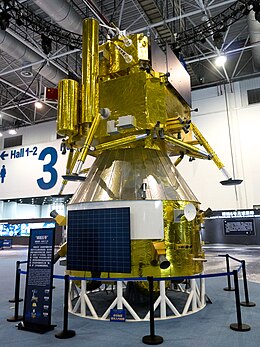Chang'e 6
Chang'e 6 (Chinese: 嫦娥六号; pinyin: Cháng'é liùhào) is a planned robotic Chinese lunar exploration mission that has been officially announced for the first half of 2024 and is expected to launch on 3 May 2024.
It will attempt China's second sample return mission. The mission will attempt to obtain the first-ever soil and rock samples from the lunar far side and return it to the Earth; the primary phase of the mission is expected to last about 53 days. Like its predecessors, the spacecraft is named after the Chinese moon goddess Chang'e.
 Chang'e-5/6 spacecraft full-stack full-scale mockup | |
| Mission type | Surface sample return |
|---|---|
| Operator | CNSA |
| Mission duration | ~53 days |
| Spacecraft properties | |
| Manufacturer | CAST |
| Launch mass | 8,200 kg (18,100 lb) |
| Start of mission | |
| Launch date | 3 May 2024 (expected) |
| Rocket | Long March 5 |
| Launch site | Wenchang |
| Moon lander | |
| Landing site | Southern edge of Apollo Basin 43°00′S 154°00′W / 43.0°S 154.0°W |
Chang'e probes | |
Overview
The Chinese Lunar Exploration Program is designed to be conducted in four phases of incremental technological advancement: The goal of the first phase is to reach lunar orbit, this was completed by Chang'e 1 in 2007 and by Chang'e 2 in 2010. The second phase seeks to land and rove on the Moon, a feat that was accomplished by Chang'e 3 in 2013 and by Chang'e 4 in 2019. The third phase involves the collection of lunar samples and sending them to Earth, first completed by Chang'e 5 in 2020 and planned for the Chang'e 6 mission. The fourth phase consists of the development of a robotic research station near the Moon's south pole. The program aims to facilitate crewed lunar landings in the 2030s and possibly build a crewed outpost near the lunar south pole.
Unlike the Chang'e 5 mission which returned in excess of 1.73 kilograms of material from the northern hemisphere of the lunar near side, the Chang'e 6 mission will attempt to land and return material from the southern hemisphere of the lunar far side. Specifically, the landing segment of the Chang'e 6 mission will target the southern portion of the Apollo crater which itself lies within the larger South Pole-Aitkin (SPA) impact basin on the lunar far side; it is hoped that samples collected from the target area may include lunar mantle material ejected by the original impact that created the SPA basin. The mission's lander will endeavor to collect up to two kilograms of lunar far-side material including surface soil and rocks (using a scoop) and subsurface samples (using a drill).
Mission architecture

Chang'e 6 was built as a copy and backup of Chang'e 5. The mission is reported to consist of four modules: the lander will collect about 2 kg (4.4 lb) of samples from 2 metres (6.6 ft) below the surface and place them in an attached ascent vehicle to be launched into lunar orbit. The ascent vehicle will then make a fully autonomous and robotic rendezvous and dock with an orbiter where the samples will be robotically transferred into a sample-return capsule for their delivery to Earth. The estimated launch mass is 8,200 kg (18,100 lb)—the lander is projected to be 3,200 kg (7,100 lb) and the ascent vehicle is about 700 kg (1,500 lb).
Science payloads
In October 2018, Chinese officials announced that they will call for international partners to propose an additional payload up to 10 kg (22 lb) to be included in this mission. In November 2022 it was announced that the mission would carry payloads from four international partners:
- a French instrument called DORN (Detection of Outgassing Radon) to study the transport of lunar dust and other volatiles between the lunar regolith and the lunar exosphere, including the water cycle;
- an Italian instrument called INRRI (INstrument for landing-Roving laser Retroreflector Investigations) consisting in a passive laser retro-reflector to be used for laser range-finding of the lander, similar to those used on the Schiaparelli and InSight missions;
- the Swedish NILS (Negative Ions on Lunar Surface), an instrument to detect and measure negative ions reflected by the lunar surface;
- the Pakistani ICUBE-Q cubesat, to detect ice traces on the lunar surface.
Launch
The probe is scheduled to be launched by a Long March 5 rocket on 3 May 2024, from Wenchang Satellite Launch Center on Hainan Island. CNSA has announced it for the first half of 2024.
See also
References
External links
This article uses material from the Wikipedia English article Chang'e 6, which is released under the Creative Commons Attribution-ShareAlike 3.0 license ("CC BY-SA 3.0"); additional terms may apply (view authors). Content is available under CC BY-SA 4.0 unless otherwise noted. Images, videos and audio are available under their respective licenses.
®Wikipedia is a registered trademark of the Wiki Foundation, Inc. Wiki English (DUHOCTRUNGQUOC.VN) is an independent company and has no affiliation with Wiki Foundation.